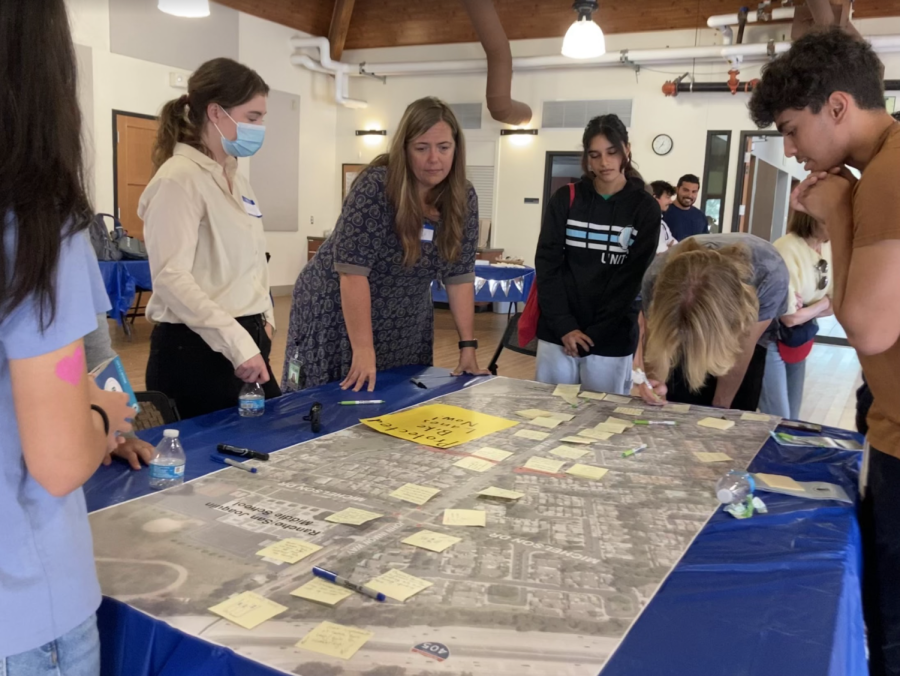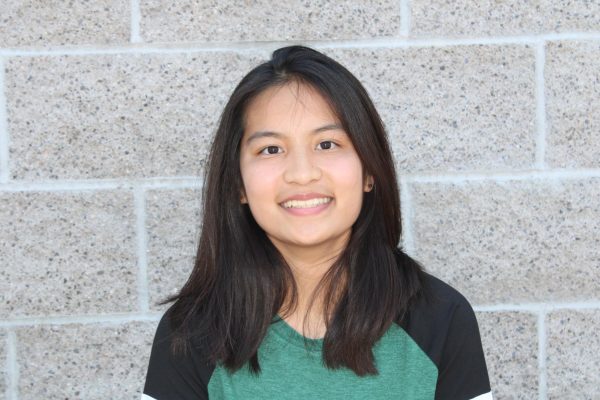UHS Environmental Policy Club Advocates for Bike Safety at Community Workshop
Environmental Policy Club members discuss ideas to improve bike infrastructure as a part of the South Yale Corridor Improvements Project.
January 4, 2023
Members of the UHS Environmental Policy Club advocated for safer bike infrastructure at the City of Irvine’s community workshop for the South Yale Corridor Improvements Project on Oct. 22. The project concerns South Yale Avenue but is part of a larger initiative to address community transportation and safety concerns with local projects like Irvine Shares the Way.
“We have a roadway that is way too wide for the amount of traffic that is currently on that street,” senior transportation analyst Cheryl Lea said.
The current width of each lane is 24 feet; by contrast, the standard width of a highway lane is half of that. Ideas for the road include protected bike lanes and an added crosswalk.
“We’re looking at opportunities to make changes and make improvements on this roadway to also accommodate bicycles and pedestrians and other roadway users,” Lea said.
Lea works for the City of Irvine’s Department of Public Works and Transportation. As a part of this project, she’s focused on improving accessibility for skateboarders, scooters, wheelchair users and bicyclists — all examples of active transportation. Though this serves multiple community sectors, much of the ridership along South Yale is made up of youth, especially high school and middle school students.
“There’s so many cars that are passing by and there’s so many students also using those bike lanes or sidewalks to get home or get to different places,” sophomore Keira Choe said. “I think there has to be definitely an improvement regarding the barrier between cars and students or just any pedestrian.”
The First Step: Community Input
The project is currently in its early stages and was originally approved by City Council in June of last year. The first part of the process is outreach, through workshops and online surveys of the community.
“The community lives here,” Lea said. “They work here. They have jobs here. They go to school here. So, they’re the most important and we want to be able to make sure we serve them and consider what their needs are.”
The city will take feedback gathered in the first phase and create designs for the community to vote on; from there, the chosen idea will go through environmental clearance, approval by the city council and eventually move into construction.
Throughout this process, city officials want to make sure citizens have a voice, especially young people who are likely to use this road.
“There’s nothing more important than making sure that we protect the safety of our students, our children and ultimately it’s your future,” mayoral candidate Branda Lin said. “So getting you guys involved, it’s key to coming up with solutions.”
UHS students engaged in discussions with each other, City of Irvine staff and project consultants like Active Transportation Manager Paul Martin from the local company Mark Thomas. Also present was UCI student Youseff Kaddeche, a vocal advocate for bike-ability, climate change reforms and youth involvement in local issues.
“It’s wonderful that we have students who are so passionate about our future in terms of environmental protections as well as coming up with transit options for them so that we can remove cars,” Lin said.
Coming Up With Solutions
Lin is in favor of a two-way cycle track for this project and increasing active transportation among students, especially when there is a high volume of traffic such as during drop-off and pickup times at local schools.
“The cycle track is an exclusive roadway area that’s made for bicycles only and it can be divided by a constructed barrier or striping,” Lea said.
This idea is one of the options for protected bike lanes that the city is considering. It would be the first cycle track in Irvine, and one of the few available in Orange County.
“Most [people] will just end up going on one lane, so to have both options on one side versus having them forced to go to the right is actually safer because there’s a lack of education,” Lin said. “A lot of people still ride their bikes on the wrong side of the road, so it makes it easier if both options are on one side.”
A concern with a two-way track is that faster eBikes and reckless bikers could be dangerous for other users. Another option was two protected bike lanes on either side of the street, which would prevent head-on collisions but be less accessible. However, most students agreed this was overstated and not a serious issue when compared to the threat of cars sharing the road with unprotected bikers.
“Especially in Irvine where it’s supposedly a great place to raise your kids, I think you definitely want your kids to be safe while they’re biking around because I know a lot of people bike to school,” senior Kuan Fu said.
The community voted with stickers on poster boards provided at the workshop, with students mainly focusing on separating and widening bikeways. They used post-it notes to add their ideas like building cement bollards and ground lighting.
“It definitely directly affects young people,” junior Skaila Sirdeshpande said. “A lot of older people can drive or they have a lot more autonomy with what they do . . . It’s a very car-dependent place.”
Many students contributed ideas and sketched out possibilities on a large printed map provided at the workshop. It was as much an exercise in urban planning as it was a forum to address issues ranging from accessibility to climate change.
“In Irvine, if you don’t have a car, you’re a second-class citizen,” senior Niko Huse said. “You really are. You’re restricted from your work, your school, your shopping, your parks – which are in easy access for those with cars.”
Urban sprawl, the rapid expansion of cities leading to low-density development, is recognized as a nationwide problem, leading America to be one of the most car-dependent countries in the world.
“There’s a big problem with urban sprawl,” Fu said. “Everything’s farther apart, so everyone’s driving and people don’t really consider that there are alternatives because it’s so ingrained in our society.”
Irvine is a master-planned community separated into villages with individual home areas, parks, a retail center and other neighborhood necessities. However, students felt that their ability to travel around the city is restricted by the lack of safe roads.
“If you want the economy to be good, you [have to] create a good experience for shoppers, and there’s no better way to do it than a walkable city where you’re not spending a bunch of money on cars,” Huse said.
Using alternatives to cars would mean less money spent both upfront and on maintenance of the cars themselves and the infrastructure they use, like highways and parking lots.
Putting the Environment in Environmental Policy
“Electric cars won’t save us,” Huse said. “What will save us are bikes, walking and trains. Trains are brilliant because you could get as many people on a couple of train cars as an entire clogged freeway.”
Huse further argued that the infrastructure needed to support cars is an unnecessary cost to the environment as they emit greenhouse gases and take up a lot of space, often intruding into natural areas such as forests.
“In the production of refining nickel, in fact, a Toyota Prius creates more environmental damage than a Land Rover Discovery over its entire lifespan,” Huse said. “And they’re just expensive.”
Measures like Proposition 30 in this year’s election are being taken to fund electric vehicles, but Huse doesn’t see this as a solution. He mainly supports getting more people to regularly use active means of transportation like biking.
“But people don’t like biking here,” Huse said. “People don’t like biking on painted bicycle gutters which cars can veer into and flatten you. People like protected bike lanes like they have all over Europe where I used to live, so that’s why I think this project is brilliant.”
By widening sidewalks or building dedicated cycle tracks, it becomes more difficult for cars to speed because of narrower lanes. The Environmental Policy Club hopes that projects like this will help with the climate by making active transportation safer and more accessible, thus taking cars off the road.
“Talking about [climate change] is really stressful because you see people like Greta Thunberg and everyone doing these really big things to try and get people to change their habits,” Sirdeshpande said. “But it’s a bit harder for smaller people and students to be able to do something about that.”
However, the club hopes this project will set a precedent for the rest of the city and eventually have a larger influence on making American infrastructure more sustainable.
“I feel like step one is just changing the daily habits,” Sirdeshpande said. “Being able to just bike somewhere rather than take a car makes all the difference because once one person does it then another person will do it. Once we make it more accessible then people will be willing to make better choices for the environment and ultimately for themselves in order to make a difference.”
To learn more about the South Yale Corridor Project, visit cityofirvine.org/sharestheway. To join or get involved with the UHS Environmental Policy Club, visit linktr.ee/uhsen.





